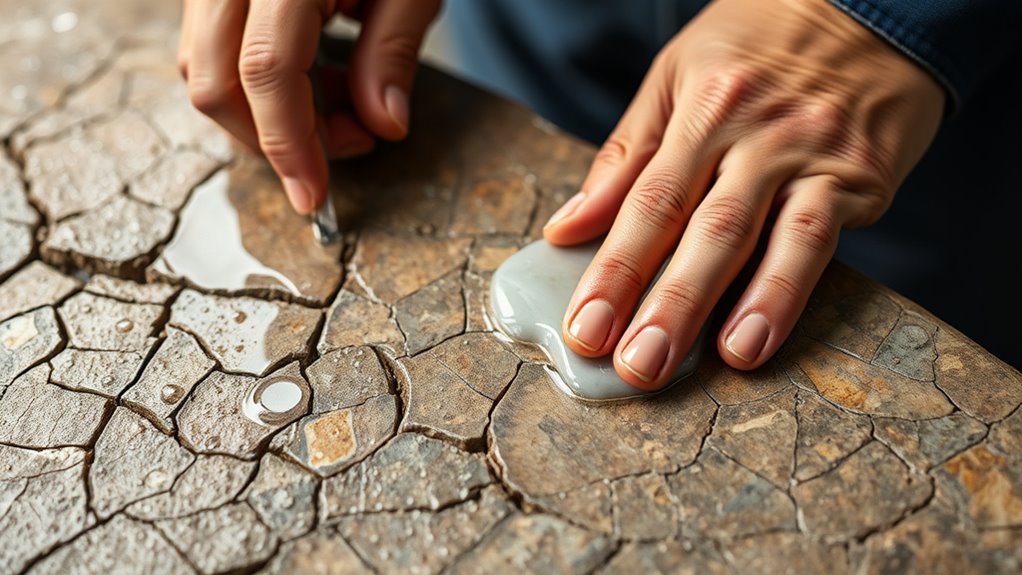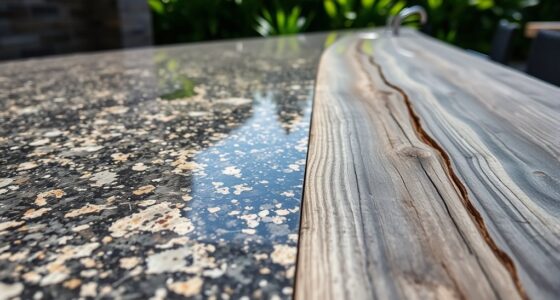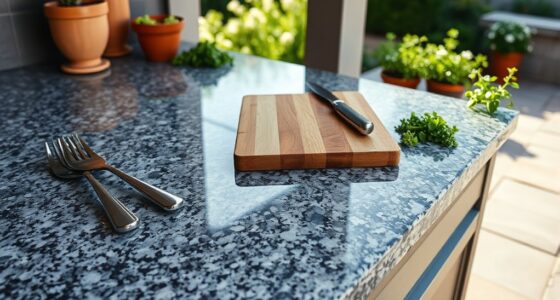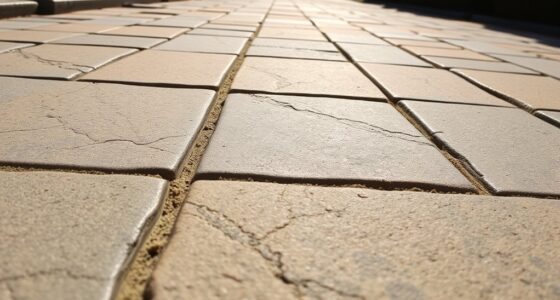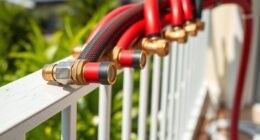To confidently clean and seal stone surfaces, you need to understand your stone type and assess its condition first. Choose pH-neutral cleaners and use soft tools to avoid damage during cleaning. After cleaning and thoroughly drying, apply a proper sealant to protect against stains and moisture. Regular maintenance, inspections, and avoiding common mistakes will extend your stone’s beauty and lifespan. Keep going to discover detailed tips to master this essential care process.
Key Takeaways
- Understand your stone type to choose appropriate cleaning methods and sealants, preventing damage and ensuring longevity.
- Use pH-neutral, non-abrasive cleaners and soft tools for effective, damage-free cleaning.
- Assess and thoroughly prepare surfaces by cleaning and drying before sealing to ensure proper adhesion.
- Seal new or cleaned stones to protect against stains, moisture, and daily wear, extending lifespan.
- Regularly inspect, clean, and reseal stone surfaces for ongoing maintenance and confident preservation.
Understanding Different Types of Stone and Their Needs
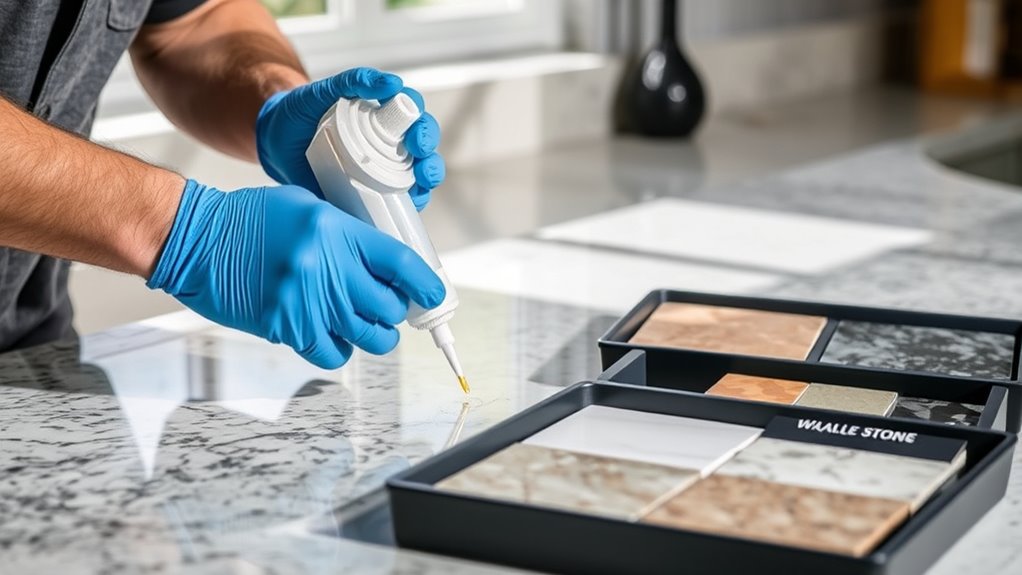
Understanding the different types of stone is essential because each one has unique properties that affect how it should be sealed and cleaned. For example, certain types of limestone are more porous, making them prone to staining if not properly sealed. Knowing the specific type helps you choose the right cleaning products and maintenance routines. Marble maintenance, in particular, requires careful attention since marble can be sensitive to acids and harsh chemicals, which can etch or dull its surface. Some stones are more durable and resistant to scratches, while others need gentler handling. Recognizing these differences ensures you avoid damage and keep your stone surfaces looking their best. Properly identifying your stone type is the first step toward effective sealing and maintenance. Additionally, understanding stone porosity can help determine the appropriate sealing frequency to prevent moisture absorption and staining.
Assessing Your Stone Surfaces Before You Start
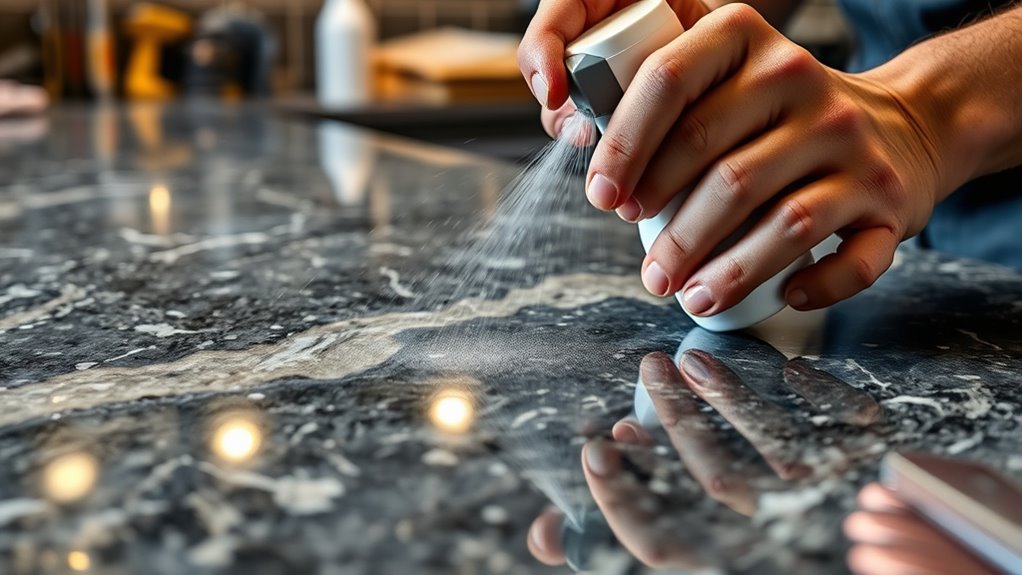
Before you begin sealing or cleaning your stone surfaces, it’s important to evaluate their current condition thoroughly. Check the surface texture—smooth, rough, or porous—to determine the best cleaning method and sealer. Notice any areas with surface damage, cracks, or chips that might need repair before proceeding. Pay attention to color variation across the surface; uneven coloring can indicate stains, wear, or underlying issues. Identifying these differences helps you decide whether deeper cleaning or specific treatments are necessary. Also, look for signs of dirt, grime, or staining that could affect the sealing process. Retail hours today can influence when you access supplies or professional services if needed. Taking this initial step ensures you understand your stone’s unique needs, setting the stage for effective cleaning and sealing that will enhance its appearance and longevity.
Choosing the Right Cleaning Products and Tools
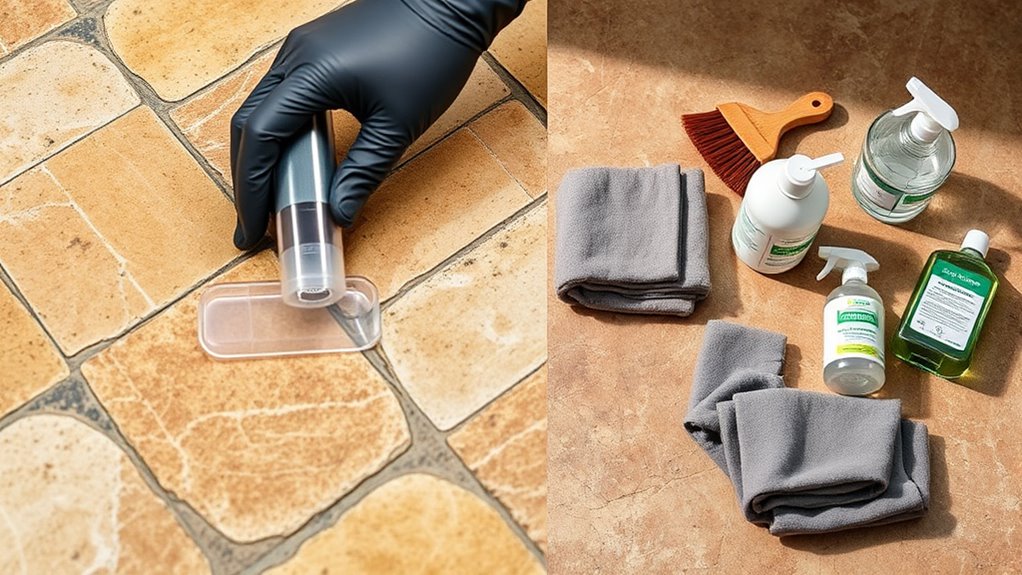
Selecting the right cleaning products and tools is essential to effectively maintain your stone surfaces without causing damage. You should choose products with a neutral pH balance to avoid etching or dulling the stone. Eco-friendly options are also beneficial, as they clean effectively while reducing environmental impact. Avoid acidic or abrasive cleaners that can harm the surface. Instead, opt for gentle, pH-balanced solutions suited for stone. Use soft cloths or mops to prevent scratches. Here’s a quick guide:
| Product Type | Suitable For | Key Features |
|---|---|---|
| pH-balanced cleaner | All stone surfaces | Gentle, effective |
| Microfiber cloth | Light dust and spills | Soft, non-abrasive |
| Eco-friendly spray | Regular maintenance | Safe, biodegradable |
| Soft-bristled brush | Stubborn stains | Gentle on surface |
| Water (plain) | Rinsing surfaces | Non-damaging, natural |
Choosing the right tools makes cleaning safe and efficient. Incorporating AI-powered cleaning tools can further optimize your maintenance routine, ensuring precision and efficiency in your cleaning process.
Step-by-Step Guide to Cleaning Stone Surfaces
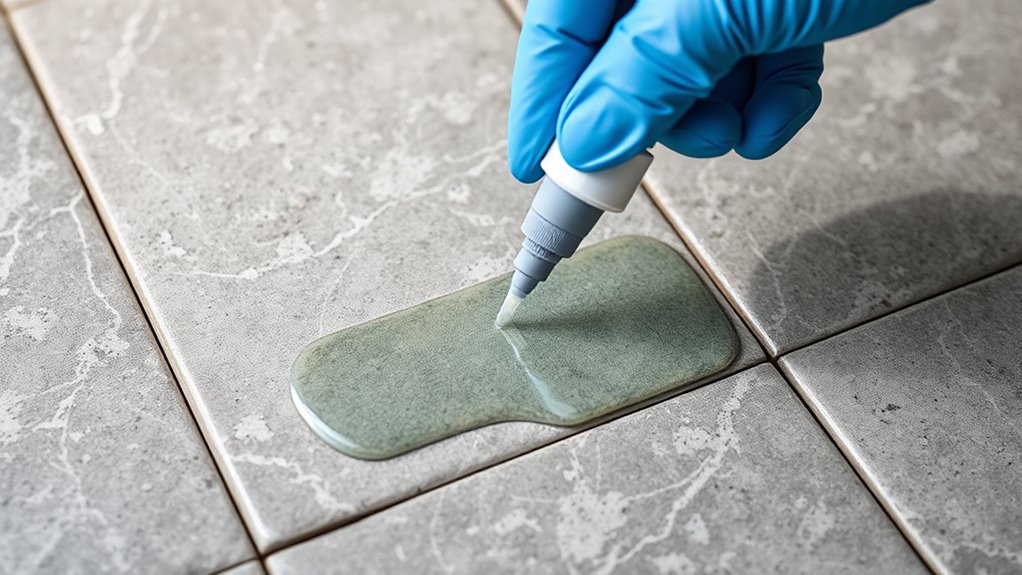
Cleaning stone surfaces effectively begins with a clear, step-by-step process that guarantees thoroughness without causing damage. Start by removing loose dirt and debris with a soft broom or vacuum. For polished finishes, use a pH-neutral cleaner mixed with water, applying it with a soft cloth or mop. Gently scrub textured surfaces with a brush to remove embedded dirt, avoiding harsh or abrasive tools. Rinse thoroughly to eliminate soap residue, then dry with a clean, soft towel to prevent water spots. For stubborn stains, apply a specialized stone cleaner or poultice, following manufacturer instructions. Always test cleaning solutions on a small, inconspicuous area first. Properly cleaning your stone preserves its natural beauty and ensures a pristine, polished finish, whether on smooth or textured surfaces. Using appropriate cleaning techniques can also help maintain the integrity of the stone and prevent damage over time.
When and Why to Seal Your Stone Surfaces

Sealing your stone surfaces is essential when they are new or after thorough cleaning, as it helps protect against stains, moisture, and everyday wear. Proper sealing preserves the natural beauty of your stone, allowing its unique patterns and colors to shine through. You should seal your surfaces when they’re new to prevent early damage and after cleaning to maintain their surface durability. Sealing creates a protective barrier that resists spills, dirt, and other damaging elements, extending the lifespan of your stone. It’s especially important in high-traffic areas like kitchens and bathrooms. By sealing at the right times, you ensure your stone remains stunning and resilient, keeping both its natural charm and structural integrity intact for years to come.
Applying Sealant: Techniques for a Perfect Finish
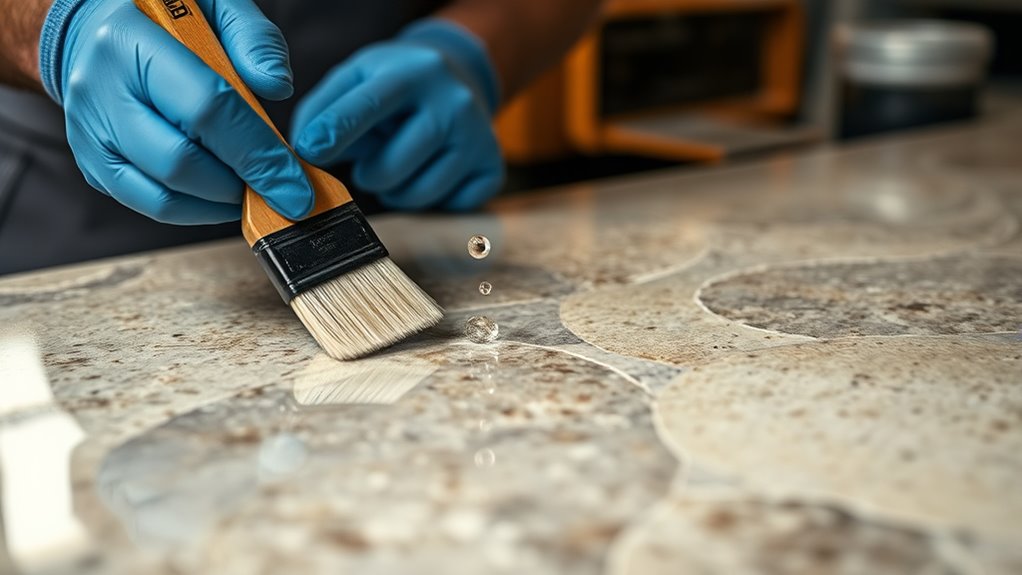
Achieving a smooth, even sealant application is essential for ideal protection and a professional-looking finish. To do this, focus on proper sealant techniques, starting with using a high-quality applicator, like a brush or roller, suited for your stone surface. Work in small sections, applying the sealant in consistent, overlapping strokes to avoid streaks. Be sure to follow the manufacturer’s instructions regarding drying times and the number of coats needed. For finishing touches, gently wipe away any excess sealant immediately to prevent buildup or uneven patches. Keep a steady hand and maintain even pressure throughout the process. Taking your time with each step ensures a flawless, durable seal that enhances your stone’s appearance and longevity. Additionally, ensuring the sealant is properly applied on clean, dry surfaces can improve adhesion and overall effectiveness application timing.
Maintaining Your Sealed Stone to Ensure Longevity

To guarantee your sealed stone remains protected and retains its beauty over time, regular maintenance is essential. Start by dust removal using a soft, damp cloth to prevent dirt buildup that can dull the surface. Incorporate stone polishing periodically to restore shine and smoothness, especially in high-traffic areas. Avoid harsh cleaners that can damage the sealant; instead, use pH-neutral products designed for stone. Promptly wipe away spills to prevent stains and etching. Regularly inspecting your stone allows you to spot small issues before they worsen. Additionally, understanding the importance of sealant durability can help you choose the right products to extend the life of your stone’s protective coating. By maintaining a routine of dust removal and gentle polishing, you extend the life of your sealant and keep your stone looking its best for years to come.
Common Mistakes to Avoid During Cleaning and Sealing

One of the biggest mistakes you can make is using harsh cleaners that harm your stone’s surface. Skipping proper sealant application or not preparing the surface thoroughly can also lead to problems down the line. Being mindful of these pitfalls helps guarantee your stone stays beautiful and protected. Additionally, neglecting to assess the stone’s personality traits and specific needs can result in ineffective cleaning and sealing strategies.
Using Harsh Cleaners
Using harsh cleaners on stone surfaces is a common mistake that can cause long-term damage. Harsh chemicals, like acids or strong alkalis, can etch or dull the stone’s surface, leading to irreversible surface damage. These cleaners may seem effective at removing stains, but they often weaken the stone’s structure over time. Instead, opt for pH-neutral cleaners specifically designed for stone. Avoid using bleach, vinegar, or ammonia, as they can compromise the integrity of your surface. Always read the label and test any cleaner on a small, inconspicuous area first. Proper cleaning preserves the stone’s natural beauty and prevents costly repairs. Remember, gentle, stone-appropriate products are your best choice for maintaining a pristine and durable surface. Being aware of narcissistic behaviors can also help in recognizing potential issues with toxic relationships that may impact your emotional well-being.
Skipping Sealant Application
Skipping sealant application during cleaning and sealing stone can lead to porous surfaces that are vulnerable to moisture infiltration and staining. Proper sealing not only enhances the appearance but also provides a protective barrier that extends the lifespan of the stone. Failing to apply sealant can result in uneven absorption, which compromises the overall finish and durability. Additionally, neglecting this step can cause difficulty in cleaning the surface later, as dirt and spills are more likely to penetrate unsealed areas. To ensure optimal results, it’s important to follow best practices and avoid common mistakes such as skipping sealant application. Regularly inspecting the surface for wear and reapplying sealant when necessary can help maintain its integrity over time. Proper filtration and pump protection during application ensure consistent spray and avoid clogs that could hinder the sealing process.
Inadequate Surface Preparation
Proper surface preparation is essential for achieving a durable and effective seal on stone surfaces. If you neglect this step, surface contamination like dirt, oil, or old sealant can trap moisture and debris beneath the new coating. This leads to inadequate sealing, which reduces the stone’s resistance to stains and damage. Before sealing, thoroughly clean the surface with the appropriate cleaner, removing all dirt, grease, and efflorescence. Allow the surface to dry completely to prevent moisture from being trapped under the sealant. Skipping proper prep or rushing through it can cause adhesion issues and weaken the seal’s effectiveness. Taking the time to prepare the surface guarantees the sealant bonds properly, providing long-lasting protection and enhancing the stone’s natural beauty. surface contamination can also include mineral deposits that require specific cleaning methods to ensure proper adhesion.
Tips for Troubleshooting and Restoring Damaged Stone Surfaces
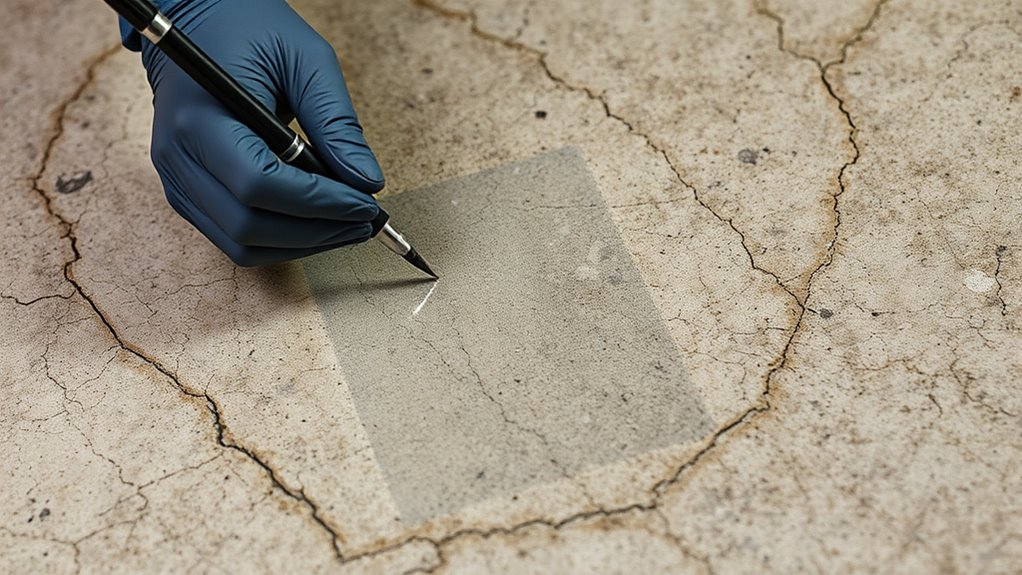
When stone surfaces become damaged or stained, addressing the issues promptly can prevent further deterioration and restore their appearance. For effective surface restoration, understanding how to troubleshoot common problems is key. Start by identifying the damage—whether it’s scratches, stains, or cracks—and choose appropriate stone repair techniques. Use gentle cleaning methods first, then consider professional restoration if damage persists. Here’s a quick emotional guide:
| Damage Detected | Action to Take | Outcome |
|---|---|---|
| Stains or discoloration | Use a specialized cleaner | Renewed vibrancy |
| Surface scratches | Apply polishing compounds | Smooth, shiny finish |
| Cracks or chips | Seek professional surface restoration | Long-lasting repair |
Timely intervention guarantees your stone retains its beauty and integrity.
Frequently Asked Questions
How Often Should I Reseal My Stone Surfaces?
You should reseal your stone surfaces every 1 to 3 years, depending on the sealant’s longevity and how much use they get. Check for signs of wear, like stains or water absorption, to determine resealing frequency. Regular resealing helps protect against spills and stains, keeping your stone looking its best. Keep an eye on the sealant’s condition, and reseal when you notice it starting to wear down.
Can Homemade Cleaning Solutions Damage Stone?
Think DIY remedies are your secret weapon? Think again. Homemade cleaning solutions can actually be the sneaky villains that damage your precious stone, like acid ruining marble’s elegance. Commercial products are designed with your stone’s safety in mind, so skip the vinegar and lemon juice. Your stone surface deserves better than kitchen experiments gone wrong—trust professional formulas over amateur chemist attempts to keep it shiny and damage-free.
Is Sealing Necessary for All Types of Stone?
Sealing isn’t necessary for all stone varieties, but it’s highly important for porous stones like limestone or marble to prevent staining and damage. For non-porous stones like granite, sealing offers extra protection but isn’t always essential. You should consider the sealing importance based on your specific stone variety, its porosity, and how much wear and tear it faces. Proper sealing helps maintain your stone’s beauty and longevity.
How Can I Tell if My Stone Needs Cleaning or Sealing?
Did you know that nearly 60% of stone damage comes from improper cleaning or sealing? To determine if your stone needs cleaning or sealing, start with pH testing—acidic or alkaline residues indicate dirt or stains. Check sealant durability by observing if water soaks in quickly or beads on the surface. If it does, it’s time to clean or reseal. Regular maintenance keeps your stone looking its best and prolongs its life.
What Are the Best Practices for Removing Stains From Stone?
To remove stains from stone, start with gentle stain removal techniques using natural cleaning agents like baking soda and water or a mix of hydrogen peroxide and mild dish soap. Apply the paste to the stain, let it sit, then gently scrub with a soft brush. Avoid harsh chemicals, and always test a small area first. Regular maintenance and prompt cleaning help prevent stubborn stains and keep your stone looking its best.
Conclusion
With the right care, your stone surfaces become a timeless canvas of elegance, gleaming softly under gentle light. As you nurture them with proper cleaning and sealing, they stand resilient against the test of time—a demonstration to your careful touch. Imagine running your hand over a smooth, polished surface that’s both beautiful and protected, whispering stories of craftsmanship and enduring beauty. Your confidence in maintaining these surfaces transforms everyday moments into lasting impressions.
